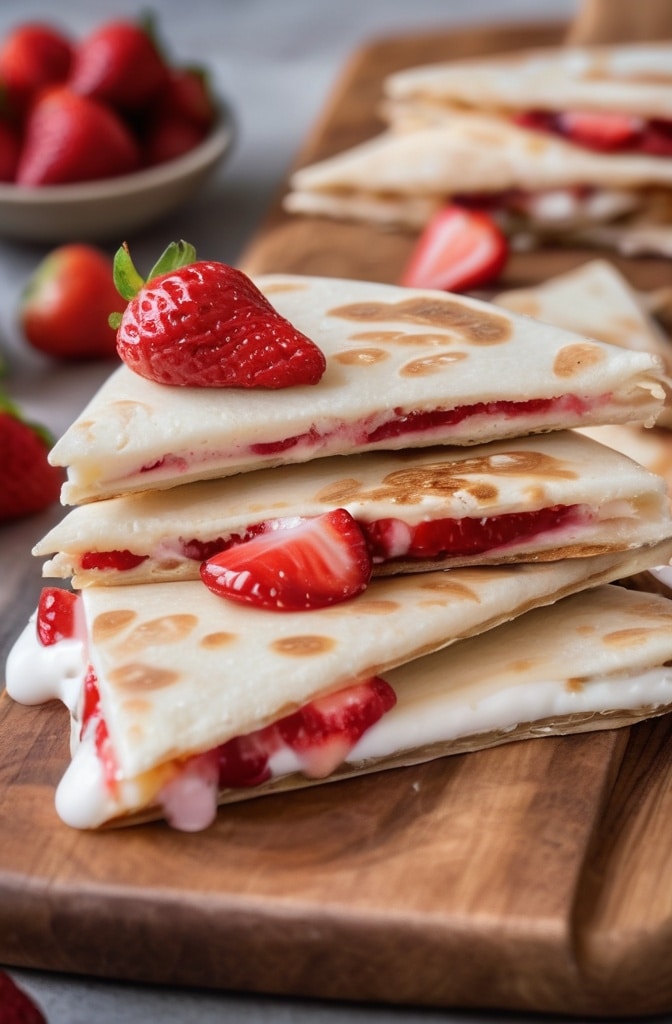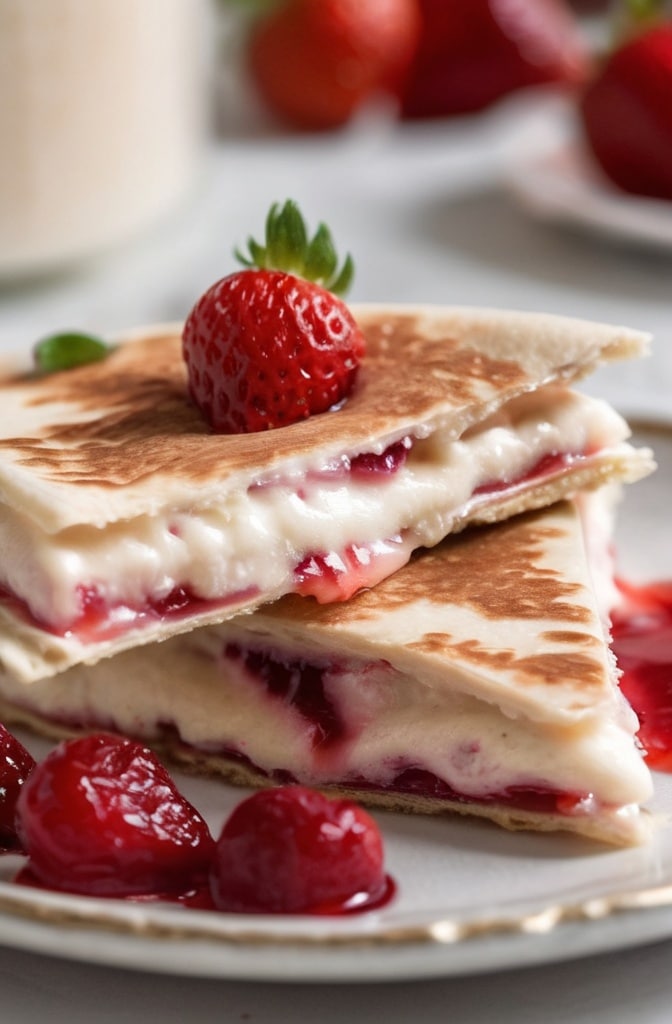The first time I witnessed a customer’s face light up after biting into a strawberry cheesecake quesadilla, I knew we’d created something magical. It was 2:00 AM at my late-night food truck in Austin, and this happy accident—born from a desperate shortage of dessert options—became our signature item overnight. That’s the beauty of culinary fusion: sometimes the most unexpected combinations create the most unforgettable experiences.
Strawberry cheesecake quesadillas represent the perfect marriage of Mexican technique and American dessert sensibilities. These crispy, golden-brown tortillas filled with creamy cheesecake mixture and fresh strawberry compote deliver a textural and flavor experience that’s both comfortingly familiar and excitingly novel. They’re dessert quesadillas that transcend the sum of there parts, creating something truly extraordinary.
1. Ingredients & Substitutions
For the Cheesecake Filling:
- 16 ounces (450g) full-fat cream cheese, softened
- 1/3 cup (67g) granulated sugar
- 1 tablespoon fresh lemon juice
- 1 teaspoon vanilla extract
- Pinch of salt
The cream cheese must be properly softened for a smooth mixture—leave it out for at least 2 hours before using. Low-fat cream cheese can substitute in a pinch, but you’ll sacrifice that luxurious mouthfeel that makes this dessert special. For dairy-free options, cultured cashew cheese works remarkably well, tho it produces a slightly different tanginess that some actually prefer.
For the Strawberry Compote:
- 2 cups (about 300g) fresh strawberries, hulled and quartered
- 3 tablespoons granulated sugar
- 1 tablespoon lemon juice
- 1/2 teaspoon vanilla extract
- Pinch of salt
Fresh strawberries deliver the brightest flavor profile, but frozen berries can work if properly thawed and drained. When berries aren’t in season, consider substituting raspberries or a mixture of berries. The sugar amount should be adjusted based on the natural sweetness of your fruit—taste and adjust accordingly.
For Assembly:
- 8 medium-sized flour tortillas (8-inch/20cm diameter)
- 4 tablespoons unsalted butter, softened
- 2 tablespoons granulated sugar mixed with 1/2 teaspoon ground cinnamon
- Powdered sugar for dusting
Flour tortillas provide the ideal crispy-yet-pliable texture, but corn tortillas can create an intriguing nutty contrast if your looking for something different. For a gluten-free version, cassava flour tortillas work wonderfully. The butter creates that perfect golden exterior, but clarified butter (ghee) offers an even more pronounced nutty flavor profile that many chefs prefer.
2. Step-by-Step Instructions

Preparing the Cheesecake Filling:
- In a stand mixer fitted with the paddle attachment, beat the softened cream cheese on medium speed until completely smooth and free of lumps, about 2 minutes. Scrape down the sides of the bowl periodically—those pesky cream cheese lumps are the enemy of a perfectly smooth filling.
- Add sugar gradually while mixing on low speed, then increase to medium and beat until fully incorporated and slightly fluffy, approximately 1-2 minutes. Most home cooks rush this step, but taking your time here ensures proper sugar incorporation and aeration.
- Add lemon juice, vanilla extract, and salt, beating just until combined. Over-mixing after adding these ingredients can cause the mixture to break and become grainy, so exercise restraince. Transfer to a bowl, cover with plastic wrap directly touching the surface (prevents skin formation), and refrigerate for at least 30 minutes to firm up.
Creating the Strawberry Compote:
- Combine strawberries, sugar, lemon juice, vanilla extract, and salt in a medium saucepan over medium heat. The salt might seem counterintuitive in a sweet application, but it’s crucial for enhancing the strawberries’ natural flavor—trust me on this one.
- Bring to a gentle simmer, stirring occasionally, and cook until berries begin to break down and release their juices, about 5-7 minutes. You’re not aiming for jam consistency; you want the berries to maintain some structural integrity while creating a luscious sauce.
- Remove from heat and allow to cool completely. The compote will thicken slightly as it cools, and the flavors will meld and intensify—patience here is rewarded with superior flavor development.
Assembling and Cooking the Quesadillas:
- Spread about 3 tablespoons of the cheesecake filling evenly over half of each tortilla, leaving a 1/2-inch border around the edge. The border prevents filling from leaking during cooking and creates that perfect sealed edge.
- Spoon approximately 2 tablespoons of strawberry compote over the cheesecake filling, spreading it gently but not mixing the layers. Maintaining layer separation creates that beautiful revelation when biting through—visual appeal is half the experience.
- Fold the empty half of the tortilla over the filled portion to create a half-moon shape. Press the edges gently to seal. At this stage, you can refrigerate assembled quesadillas for up to 2 hours if preparing ahead for service.
- Lightly spread the outside of each quesadilla with softened butter. Most people under-butter—be generous here as it creates that perfectly crisp, golden exterior and adds crucial flavor.
- Heat a large non-stick skillet or well-seasoned cast iron pan over medium heat. Cook quesadillas one or two at a time (depending on pan size) for 2-3 minutes per side until golden brown and crisp. The ideal temp is when butter sizzles but doesn’t immediately brown when the quesadilla hits the pan.
- Immediately after removing from heat, sprinkle with cinnamon-sugar mixture while still hot so it adheres to the buttery exterior. Transfer to a cutting board and let rest for 1 minute before cutting—this crucial rest allows the filling to set slightly for cleaner slices.
3. Cooking Techniques & Science
The magic of strawberry cheesecake quesadillas lies in understanding several key culinary principles that elevate them from simple to sophisticated. First, the contrast between temperatures and textures creates complexity—the hot, crispy exterior against the cool, creamy interior provides what food scientists call “dynamic contrast,” a hallmark of addictive foods.
The caramelization that occurs when cooking the butter-coated tortillas triggers the Maillard reaction—a chemical process between amino acids and reducing sugars that creates hundreds of distinct flavor compounds. This is why properly browned quesadillas taste so much more complex than their pale counterparts. Dark golden-brown (not black!) is what your aiming for.
The slight acidic tang from the cream cheese and lemon juice balances the sweetness of the compote through a process called “flavor bridging.” This technique—using complementary elements to connect seemingly disparate flavors—is what makes these quesadillas taste cohesive rather than like two separate components.
Traditional Mexican cooks have been leveraging the structural properties of corn and wheat proteins in tortillas for centuries. The gluten in flour tortillas provides elasticity that allows for the crisp exterior while maintaining a tender chew—properties that aren’t accidental but the result of precise protein-starch relationships.
When making the strawberry compote, we’re carefully managing pectin—the natural gelling agent in fruit. The brief cooking time breaks down just enough pectin to create a sauce-like consistency while preserving the fresh flavor compounds that are volatile and easily lost with prolonged heating.
4. Serving & Pairing Suggestions
Serve strawberry cheesecake quesadillas immediately after cooking, cutting each into 2-3 triangular sections for easy handling. A light dusting of powdered sugar adds visual appeal and a subtle sweetness that melts on the tongue. For restaurant-quality presentation, plate at a slight angle, overlapping the triangles slightly, with a small ramekin of additional compote on the side.
Enhance the plating with complementary elements: a small quenelle of lightly sweetened whipped cream, a fresh mint sprig, and perhaps a few thin slices of fresh strawberry arranged artfully around the plate. A drizzle of aged balsamic reduction creates a sophisticated visual and flavor contrast that cuts through the richness.
For beverage pairings, consider the balance of sweetness and acidity. A late-harvest Riesling with notes of honey and stone fruit complements without overwhelming. For non-alcoholic options, a sparkling elderflower pressé or a chamomile-vanilla tea brings floral notes that enhance the strawberry’s natural fragrance.
These quesadillas transition beautifully from casual brunch item to elegant dinner party finale. For brunch, serve alongside a frothy cappuccino or fresh-squeezed orange juice spiked with prosecco. For dinner parties, elevate with a scoop of high-quality vanilla bean ice cream and a tableside pour of warm white chocolate ganache.
The versatility extends to customization opportunities—offer a “build-your-own” dessert quesadilla bar for gatherings, with various fruit compotes, chocolate chips, toasted nuts, and spiced sugars for rim coating. This interactive approach makes for memorable entertaining while showcasing the concept’s adaptability.
5. Variations & Creative Twists
Like any great culinary template, strawberry cheesecake quesadillas invite creative interpretation. For a tropical variation, substitute the strawberry compote with a mango-passionfruit mixture and add toasted coconut between the layers. The acidity of the passionfruit performs the same balancing function as the lemon in the original.
An autumnal version features spiced apple compote with caramelized elements—think thinly sliced apples cooked down with brown sugar, cinnamon, nutmeg, and a splash of bourbon. This variation pairs exceptionally well with a dollop of salted caramel and candied pecans.

For chocolate lovers, incorporate a thin layer of high-quality melted dark chocolate between the cheesecake filling and the tortilla. The chocolate solidifies slightly upon cooling, creating a delicate shell that cracks pleasingly when bitten, revealing the creamy interior—a textural masterpiece.
Savory-sweet crossover variations have proven particularly successful in test kitchen trials. A goat cheese and fig compote version with a honey-thyme drizzle bridges the dessert-cheese course divide beautifully. Similarly, a mascarpone and cherry combination with a balsamic reduction appeals to more sophisticated palates.
The basic technique can also be miniaturized for elegant passed hors d’oeuvres. Using 3-inch tortillas and a piping bag for precise filling application creates two-bite dessert canapés that hold well on a serving tray without becoming soggy—ideal for catering applications.
Conclusion
Strawberry cheesecake quesadillas represent what I love most about modern cuisine—the fearless fusion of techniques and traditions to create something simultaneously comforting and surprising. They honor the quesadilla’s heritage while reimagining its potential, proving that culinary innovation doesn’t require molecular gastronomy or expensive equipment—just creativity and understanding of fundamental principles.
The contrast of textures—crisp exterior yielding to creamy filling and tender fruit—creates a multisensory eating experience that satisfies on multiple levels. The balanced flavor profile ensures neither component overwhelms the other, while the familiar format makes this sophisticated dessert approachable for any diner.
Beyond there objective deliciousness, these dessert quesadillas offer practical advantages for professional kitchens: components can be prepared ahead, assembly is quick, cooking time is minimal, and the concept can be endlessly varied to utilize seasonal ingredients or reflect different cultural influences.
Whether you’re looking to add an innovative dessert to a restaurant menu, create a signature item for a food truck, or simply impress dinner guests with something unexpected, strawberry cheesecake quesadillas deliver on both creativity and execution. They remind us that sometimes the most brilliant culinary ideas come from playful experimentation and crossing boundaries—a lesson worth remembering in any kitchen.
FAQs About Delectable Strawberry Cheesecake Quesadillas
Can I prepare these quesadillas ahead of time?
You can prepare all components up to 24 hours in advance and store separately (refrigerate the filling and compote, keep tortillas at room temperature). For best results, assemble no more than 2 hours before cooking and keep refrigerated. The butter should be applied just before cooking to prevent the tortillas from becoming soggy.
Why is my cheesecake filling runny?
The most common culprit is cream cheese that’s too warm or over-beaten. Ensure your cream cheese is softened but still cool to the touch, and stop mixing once ingredients are incorporated. If it’s already runny, refrigerate for 30-45 minutes to firm up before assembling.
Can these be baked instead of pan-fried?
Absolutely! Brush both sides with melted butter, place on a parchment-lined baking sheet, and bake at 375°F (190°C) for 8-10 minutes, flipping halfway through. You’ll sacrifice some of the direct heat caramelization but gain the ability to cook multiple portions simultaneously for service.
How do I prevent the filling from leaking during cooking?
First, don’t overfill—3 tablespoons of cheesecake filling and 2 tablespoons of compote is the ideal ratio for an 8-inch tortilla. Second, leave that critical 1/2-inch border. Finally, use a fork to crimp the edges similar to a pie crust for a more secure seal when serving at high-volume events.
What’s the best way to reheat leftovers?
While best enjoyed fresh, leftovers can be refrigerated for up to 2 days. Reheat in a dry skillet over medium-low heat for 1-2 minutes per side to restore crispness. Avoid microwaving, which will make the tortilla soggy and cause the filling to become too runny.

